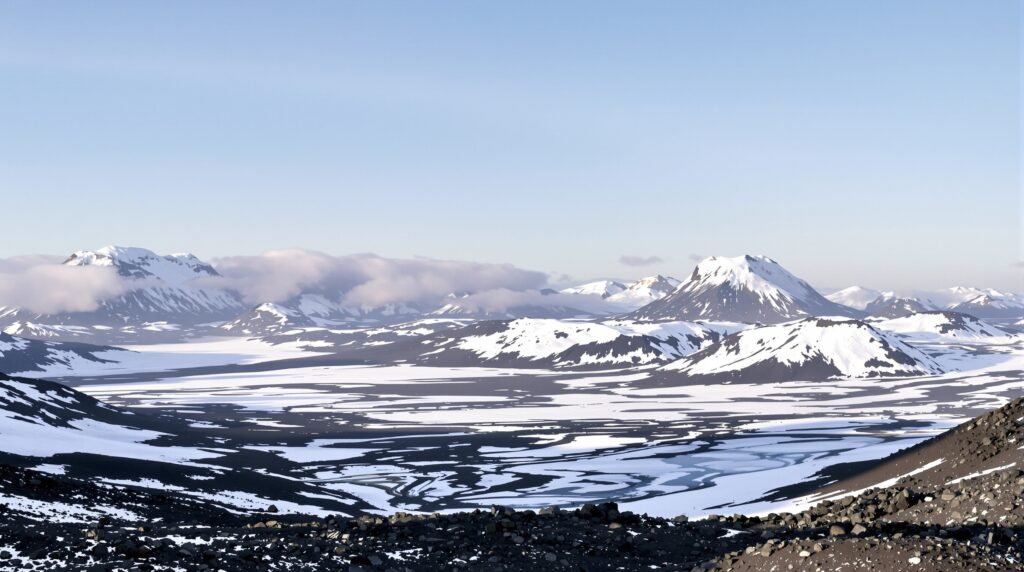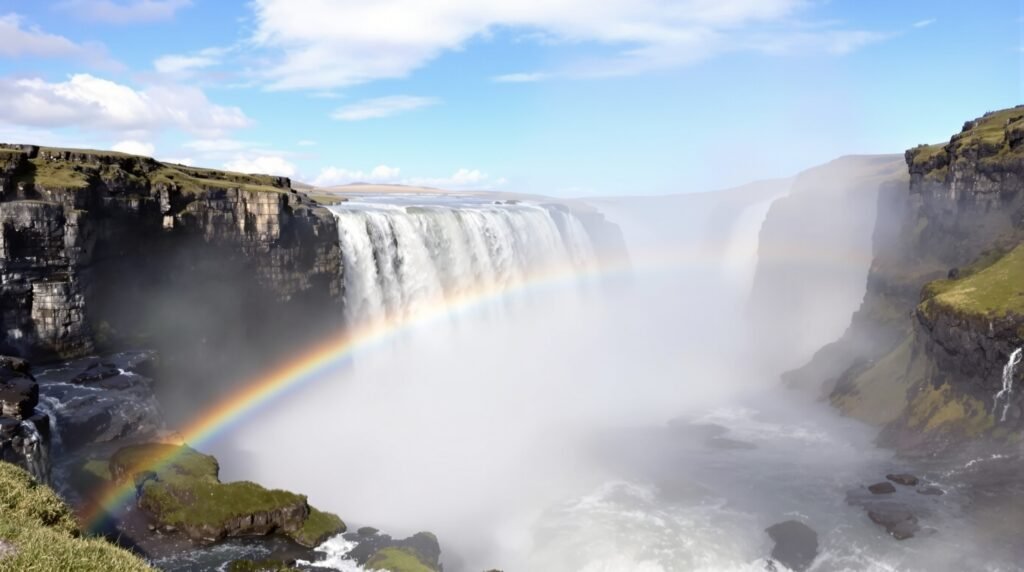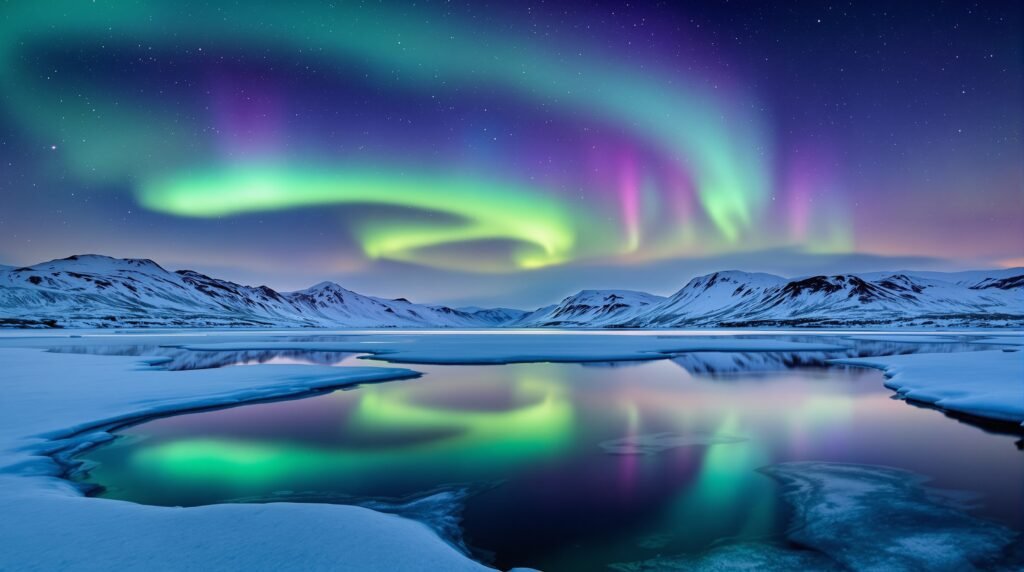Introduction to Iceland: The Land of Fire and Ice

Iceland is a striking island nation located in the North Atlantic Ocean, renowned for its stunning contrasts and dramatic landscapes. Often referred to as the “land of fire and ice,” this title aptly describes the unique geographical features that define the country. Iceland’s topography is a fascinating mix of active volcanoes, geothermal hot springs, majestic waterfalls, and vast glaciers, all coexisting in an environment shaped by dynamic geological processes. This remarkable interplay of elements offers a glimpse into the Earth’s raw power and beauty, establishing Iceland as a must-visit destination for nature enthusiasts and adventurers alike.
The term “fire” in Iceland’s nickname alludes to the numerous volcanoes that dot the landscape, many of which remain active. These volcanic systems contribute to the island’s geothermal energy, creating hot springs and bubbling mud pools that are popular with travelers. Conversely, the “ice” signifies the expansive glaciers that cover approximately 11% of the country’s surface area. Among these, Vatnajökull stands as Europe’s largest glacier, offering breathtaking vistas and opportunities for exploration.
The Best Waterfalls in Iceland
Iceland is renowned for its breathtaking natural beauty, and its waterfalls are among the most captivating features of the landscape. Each waterfall has its unique charm and characteristics, making them must-visit sites for travelers. Three of the most impressive waterfalls in Iceland are Gullfoss, Seljalandsfoss, and Skógafoss, each offering distinct experiences for visitors.

Gullfoss, often referred to as the “Golden Falls,” is located in the southwestern part of the country. This powerful waterfall cascades in two tiers, plunging a total of 32 meters into a rugged canyon. The spectacle of water thundering over the rocks creates a stunning display, especially on sunny days, when rainbows can often be seen arcing over the falls. Accessibility to Gullfoss is straightforward, with well-maintained paths leading to various viewpoints, making it an ideal spot for photographers seeking to capture the natural beauty of northern lights Iceland during the winter months.
Seljalandsfoss is another iconic waterfall, notable for its unique accessibility. Visitors can walk behind the waterfall, allowing for a unique perspective and photographic opportunities that are rarely found elsewhere. At 60 meters high, Seljalandsfoss is stunningly beautiful and provides an excellent spot for a memorable photo, particularly during sunset or sunrise when the light beautifully illuminates the cascading water. Ensure to wear waterproof clothing when visiting, as the mist can be quite intense.
Lastly, Skógafoss is renowned for its impressive width of 25 meters and height of 60 meters. Situated near the town of Skógar, this majestic waterfall is easily accessible from the Ring Road and is a popular stop for travelers. The sight of the water plunging down creates a dramatic effect, with countless rainbows often visible on sunny days. The staircase leading to an observation platform at the top provides panoramic views of the surrounding landscape, representing the rugged beauty of Iceland’s natural wonders.
Exploring Iceland’s Glaciers
Iceland, renowned for its breathtaking landscapes, boasts some of the largest glaciers in Europe, including Vatnajökull and Snæfellsjökull. These majestic ice masses cover extensive areas, adding to the island’s allure and providing a striking contrast to its waterfalls, volcanoes, and hot springs. Vatnajökull, the largest glacier in Iceland, is a UNESCO World Heritage Site, featuring vast ice caps, deep crevasses, and stunning ice formations. Snæfellsjökull, situated within the Snæfellsjökull National Park, is particularly famous for its picturesque scenery and is often considered a source of inspiration due to its mystical charm.
For adventure enthusiasts, exploring these glaciers offers a range of exhilarating activities, including glacier hiking, ice climbing, and ice cave tours. Glacier hiking is an accessible way for visitors to experience the breathtaking beauty of these icy landscapes. Guided tours typically lead participants along safe paths, where they can witness the unique blue ice and intricate formations that glaciers create. Ice climbing, while more demanding, is an option for those seeking a thrilling experience. This activity requires specialized gear and training to ensure safety while ascending frozen ice walls.
Additionally, visiting ice caves presents an extraordinary opportunity to explore the interior of glaciers. These natural formations, with their mesmerizing swirling patterns and stunning shades of blue, are often formed by meltwater. It is important to join guided tours when exploring ice caves, as they are constantly changing and carry inherent risks. Safety measures, including wearing proper gear such as crampons and helmets, are essential to enjoy these activities responsibly. The captivating beauty of Iceland’s glaciers is a must-see for any traveler, offering unforgettable encounters with nature’s raw power and artistry.
Chasing the Northern Lights

The Northern Lights, or Aurora Borealis, is a breathtaking natural spectacle that attracts thousands of visitors to Iceland every year. This phenomenon occurs when charged particles from the sun collide with atoms in Earth’s atmosphere, resulting in vibrant displays of color that dance across the sky. The beauty of the northern lights in Iceland is unparalleled, standing out against the backdrop of its stunning landscapes including waterfalls and glaciers.
To witness this celestial display, the best time to visit is between late September and early April. During these months, the long dark nights and clearer skies provide optimal conditions for viewing the Northern Lights. Iceland’s location near the Arctic Circle further enhances your chances of catching this elusive show. Popular spots to observe the Aurora Borealis include Þingvellir National Park, Jökulsárlón Glacier Lagoon, and various rural areas far from city lights.
When planning your trip to see the Northern Lights, consider the weather conditions. Ideal viewing conditions entail clear skies with minimal cloud cover and little to no light pollution. Be prepared for rapidly changing weather, as clear skies can quickly become overcast. Some recommend using weather apps that track aurora forecasts to increase your likelihood of success.
For those keen on capturing the beauty of the Northern Lights through photography, utilizing a tripod is essential for stability. Set your camera to a high ISO and a long exposure time, adjusting for the perfect lighting to showcase the vibrant colors. Joining guided tours can also enhance your experience, as knowledgeable guides often take seekers directly to the best viewing locations, while providing insights into the science behind this mesmerizing occurrence.
In conclusion, planning your adventure around the northern lights in Iceland offers a once-in-a-lifetime opportunity to witness a stunning manifestation of nature. Equip yourself with the right tools and knowledge, and prepare to be captivated by this spectacular display in a landscape rich with majestic waterfalls and ancient glaciers.
Seasonal Highlights: When to Visit Iceland
Iceland is a year-round destination, with each season offering distinct advantages and unique experiences for travelers. Understanding the seasonal highlights can significantly enhance your visit, especially when considering attractions like waterfalls, glaciers, and the mesmerizing northern lights Iceland has to offer.
Summer, from June to August, boasts the famous midnight sun, allowing for extended daylight hours to explore the stunning landscapes. During this time, popular waterfalls such as Gullfoss and Seljalandsfoss can be enjoyed under the warm sun. Glacial hikes become accessible, allowing visitors to traverse the magnificent tongues of ice that characterize the Icelandic wilderness. Additionally, summer offers numerous opportunities for whale watching and experiencing vibrant wildlife, including numerous bird species that nest along the coastal cliffs.
As autumn approaches, from September to November, the landscape transforms with vivid foliage and clear skies. This is a prime time for witnessing the northern lights in Iceland, as the crisp air and dark nights create perfect viewing conditions. Travelers can also enjoy the waterfalls cascading with significantly less runoff than in summer, making for stunning photographs. Autumn is considered a shoulder season, providing a quieter experience with fewer tourists.
Winter, spanning December to February, unveils a magical world of snow-covered landscapes and a remarkable array of ice caves. The stunning glaciers, such as Vatnajökull, are particularly breathtaking during this time. Winter also offers unparalleled opportunities to witness the northern lights Iceland is renowned for, with optimal aurora viewing conditions occurring during the long, dark nights. Outdoor enthusiasts can indulge in winter sports such as snowmobiling on glaciers and ice fishing in frozen lakes.
Finally, spring, from March to May, brings forth a renewal of life in Iceland. As the snow begins to melt, waterfalls thunder with spring runoff, and the glaciers start to recede. This is an excellent time for photography, as the combination of blooming wildflowers, icy landscapes, and the last chances to view the northern lights create a picturesque scene. Spring also marks the return of migratory birds, offering an additional layer of wildlife experiences.
Hidden Gems: Off-the-Beaten-Path Attractions
Iceland is renowned for its iconic landscapes, including breathtaking waterfalls, formidable glaciers, and the captivating northern lights. However, beyond the well-trodden tourist paths lie hidden gems that offer a serene escape into the beauty of this Nordic island. Visiting these lesser-known attractions can provide unique experiences that are just as awe-inspiring.
One such hidden gem is the enchanting waterfall, Haifoss. Tucked away in the Þjórsárdalur Valley, Haifoss stands as one of Iceland’s tallest waterfalls, cascading down in dramatic fashion and surrounded by rugged basalt cliffs. Its remote location means fewer crowds, allowing visitors to appreciate the natural beauty and tranquility of the area. A short hike leads to the viewing points, where the stunning vistas are complemented by the sounds of rushing water, making it a perfect spot for photography enthusiasts or nature lovers seeking solitude.
Another off-the-beaten-path attraction is Reykjadalur Hot Springs, located just a short drive from Selfoss. This geothermal area features a beautiful river with naturally heated waters, inviting visitors to soak in a picturesque setting that feels remote and untamed. The hike to the hot springs is manageable, and along the way, travelers can experience varying landscapes, including lush valleys and expansive views. It’s the ideal escape for those wishing to unwind in nature while enjoying the scenic beauty of Iceland away from common tourist destinations.
For those wanting to explore quaint locales, the village of Vik offers a serene coastal experience. Known for its black sand beaches and striking rock formations, Vik allows an exploration of Iceland’s mesmerizing coastline while providing opportunities for hiking and birdwatching. Exploring these hidden gems will undoubtedly enrich your travel experience, showcasing the diverse beauty of waterfalls, glaciers, and the vibrant landscapes of Iceland.
Practical Tips: Travel and Sightseeing in Iceland
When planning your visit to Iceland, especially if you are interested in witnessing the enchanting northern lights, it is crucial to consider various practical aspects to enhance your experience. Transportation options in Iceland can vary significantly depending on your itinerary. Renting a car can be one of the most convenient ways to explore the country’s stunning waterfalls, glaciers, and other breathtaking landscapes, as it provides flexibility in timings and routes. However, ensure you are comfortable driving in potentially challenging weather conditions, as Icelandic weather can change rapidly.
If you prefer not to drive, Iceland also offers a reliable public transportation system, including buses that connect major attractions. Tour companies frequently offer guided excursions, particularly for northern lights viewing, which can simplify travel arrangements for visitors lacking experience in the region. Choosing a reputable tour operator can maximize your enjoyment and enhance your safety.
Accommodation in Iceland ranges from luxury hotels to budget-friendly hostels and guesthouses, catering to various preferences and budgets. Booking in advance is advisable, especially during peak tourist seasons when demand is high. Many lodgings are situated conveniently near popular attractions, making it easier to plan day trips to nearby glaciers and waterfalls.
As you prepare for your trip, it is essential to pack adequately for fluctuations in weather. Treasuring the experience of the northern lights will require warm clothing, as temperatures can drop significantly at night. A good layering system with waterproof outer layers will protect against both wind and potential rain—necessary for outdoor excursions. Additionally, bringing along a reliable camera will aid in capturing the unparalleled beauty of Iceland’s landscapes and natural phenomena.
In conclusion, being prepared for Iceland’s unique climate and diverse attractions will undoubtedly enrich your travel experience. Whether you are exploring the majestic waterfalls, traversing glaciers, or chasing the northern lights, taking practical steps will help ensure a memorable visit to this spectacular destination.
Cultural Insights: Embracing Icelandic Heritage
Iceland is a land steeped in rich cultural traditions and a long history that captivates many visitors. The unique combination of natural beauty, including waterfalls and glaciers, and the country’s historical roots offer an intriguing backdrop for cultural exploration. To fully appreciate Iceland, it is essential to engage with its heritage, which is reflected in its customs, language, and art.
One key component of Icelandic culture is the emphasis on storytelling. The sagas, which are medieval tales, provide intricate narratives about early settlers and their adventures, woven with elements of folklore. Travelers can visit the National Museum of Iceland in Reykjavik to gain deeper insights into these stories and their implications for contemporary life. Exploring local literature allows one to understand the Icelandic worldview and the enduring value placed on literature and oral traditions.
Cuisine is another integral part of the cultural experience. Traditional Icelandic dishes, such as fermented shark (hákarl), lamb soup, and fresh seafood, characterize the local gastronomy. Many restaurants offer a modern twist on these traditional foods, providing a more accessible introduction to Iceland’s culinary landscape. Visitors are encouraged to sample dishes at local eateries, enhancing their experience of everyday Icelandic life.
Cultural events play a significant role in celebrating Icelandic heritage. Festivals like Þorrablót, held during the winter months, celebrate the arrival of spring with distinct foods and traditional festivities. This event offers an authentic way to engage with Icelandic customs. Similarly, the Reykjavik Arts Festival showcases local artists and promotes the vibrant arts scene that flourishes amidst the stunning landscapes of waterfalls and glaciers.
Understanding and respecting local traditions enrich the travel experience and foster a connection between visitors and the unique heritage of Iceland. This appreciation enhances one’s journey through this captivating destination.
Conclusion: Planning Your Iceland Adventure
As we conclude our exploration of Iceland, it is essential to reflect on the remarkable experiences that await you in this breathtaking destination. From the majestic waterfalls that cascade down lush cliffs to the mighty glaciers that dominate the landscape, Iceland offers a diverse range of natural wonders that are impossible to overlook. Each location, be it the iconic Gullfoss or the serene beauty of Seljalandsfoss, provides visitors with a unique perspective and unforgettable memories.
Moreover, one of the most enchanting highlights of any trip to Iceland is the opportunity to witness the northern lights. The ethereal display of colors dancing across the night sky captivates many travelers and leaves a lasting impression. These awe-inspiring moments, combined with the stunning vistas of glaciers and the unique geothermal features scattered throughout the country, make Iceland a destination unlike any other.
When planning your adventure, consider the best times to visit to maximize your experiences—especially if your goal is to capture the northern lights. The winter months typically offer the best chances for visibility, while the summer months provide extended daylight hours to explore Iceland’s natural beauty. It’s crucial to also plan your itinerary to include various regions of the country, ensuring that you visit multiple waterfalls, hikes through glacier terrains, and charming coastal towns.
Ultimately, your dream trip to Iceland is well within reach. With proper planning and a desire to immerse yourself in the breathtaking landscapes, your adventure will surely be an extraordinary experience. Embrace the chance to explore waterfalls, glaciers, and the mesmerizing northern lights, and create memories that will last a lifetime.
Travel Bali


